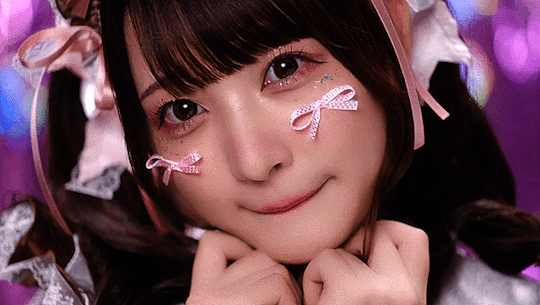#げん
Explore tagged Tumblr posts
Text

💜✨ The chirping of the songbirds at daybreak always puts me in the best of moods✨💜
Throwback to last Comic Con with Yun Jin!! She was such a blast to cosplay and still holds the title of “fave 4 star” 💗💗
Photo by: @ham.cosplay.photog
Cosplay: @dokidokicosplay_official
Wig: @dokidokicosplay_official
Shoes: @dokidokicosplay_official
#kawaii#cute#cosplay#genshin impact#yun jin#genshin cosplay#genshin impact cosplay#yun jin cosplay#dokidokicosplay#yun jin genshin impact#comic con#adelaide comic con#oz comic con#kawaii cosplay#cute cosplay#genshin impact yun jin#gamer girl#photoshoot#convention#comic con 2023#cosplay girl#かわいい#コスプレ#可愛い#原神#げん#云堇
11 notes
·
View notes
Text

まんげつ🍵くも
5K notes
·
View notes
Text

Created by : ☆おこげせん☆ Respective credits to the creator ⓟⒶⓇⒶⒹⒾⓈⒺ♡ⓎⓊⓇⒾ
#Yuri#百合#GL#Liz to Aoi Tori#hibike euphonium#Mizore Yoroizuka#Nozomi Kasaki#lesbian kissing#WLW#so cute!#Art by#おこげせん#@okogesen#please support the artist in x!
421 notes
·
View notes
Text

まんげつ🍵くも
877 notes
·
View notes
Text

新刊表紙用 by はんげつ15 [Twitter/X] ※Illustration shared with permission from the artist. If you like this artwork please support the artist by visiting the source.
195 notes
·
View notes
Text

359 notes
·
View notes
Text
JLPT N5 - あげる
At its simplest, あげる means “to give”. At the N5 level, it’s used for giving physical things such as presents, money, water (to plants), food (to pets), etc. There is another way it can be used, but that is for a later JLPT level. For now, let’s get into ONE of the ways you can talk about giving in Japanese.
First, here is the vocabulary for this post.

【The Grammar of あげる】
Basically there are 4 parts to every あげる sentence that you should be thinking about. The first 3 are marked with particles and the last part is the verb.

Here is an example sentence:
① 【けんじは】【トムに】【腕時計を】あげた。
= As for Kenji, to Tom, a watch gave
= Kenji gave Tom a watch.
In a sentence like #1 it’s easy to see the 3 parts clearly marked with particles and then the verb at the end. Unfortunately you WILL NOT always see simple sentences like this, so let’s look at each part one by one, along with the cultural context behind あげる.
【The Giver】
Most of the time, the giver will be marked by the は (or sometimes the が) particle. This is because あげる sets up the action of giving from the giver’s perspective.
Sometimes, it is obvious who the giver is, so that phrase can be completely left out of the sentence.
② 【会社の人たちに】【お土産を】あげると思う。
= to the people at (my) company, souvenirs will give I think
= I think I’m going to give the people at my company souvenirs.
In this sentence it would be clear that the speaker is the giver. Therefore it’s not necessary to include a 私は phrase.
【The Relationship Between Giver and Receiver】
Before we move on, let’s get into a very big cultural difference between Japan and English-speaking cultures. When you use あげる, you have to think about the relationship between the giver and the receiver. In English, this doesn’t affect the words we use, but in Japanese it is actually very important when it comes to word choice. Take a look at this image:

The green circle would include close friends, family, your lover, etc. Pets and plants would also fall into this circle. Outside of the green circle are strangers, teachers, professors and depending on your job, your customers. This is because showing respect is directly connected to setting up a kind of psychological distance. You have to work hard and gain trust before you are moved into the green circle.
Some people, like coworkers and bosses, may be inside the green circle in some situations, but outside of it in other situations! A common example is when you go out drinking with coworkers. As the alcohol flows throughout the night you’ll notice that psychological space slowly disappearing - that is until the next day at work. They might act like the person you drank with was a COMPLETELY different person!
This way of thinking is called うちそと, and can be a very difficult part of Japanese culture for many foreigners. Here’s the thing: the culture of うちそと extends to the concept of giving as well.
【Giving Culture and あげる】
When it comes to giving, there are 4 situations where it’s appropriate to use the verb あげる:
① When you give something to someone inside your inner circle
② When you give something to anyone outside your inner circle
③ When someone in your inner circle gives something to someone outside your inner circle
④ When someone outside your inner circle gives something to another person outside your inner circle
Numbers 1-3 can be described as the act of giving while moving from a smaller circle to a bigger circle. Number 4 can be described as giving that doesn’t happen in your inner circle.

There are of course more possibilities when it comes to giving (and receiving). However, those situations won’t use the verb あげる!
【What Is Being Given】
In most sentences, whatever is being given is very simply marked with the を particle. However, there are times when the を particle or the positioning of what is being given will change. Take a look at these three example sentences:

Example 3a is the “default version”. The doll is marked with the を particle so we immediately know that it will be given to someone (the section manager’s wife).
For example 3b I want you to imagine that you are in a souvenir shop. You’ve bought a couple of things already, but you haven‘t decided which gifts will go to whom. All of a sudden, you see a doll that catches your eye. You immediately think to yourself, “that doll is perfect for the section manager’s wife”. Putting the item being given (that is, the doll) at the head of the sentence shows that 1) you are putting the focus of your sentence on that item and 2) there is a kind of impulsiveness to the giving. It’s kind of an instant decision.
Compare that with example 3c. Now I want you to imagine that you are in your house. You bought a bunch of dolls but you haven’t decided which one will go to whom. You pick up one of them and after some thought you say, “Ok I’ll give THIS one to the section manager’s wife.” Marking the doll with は serves to emphasize that there are several dolls, but you are highlighting one of them for a specific reason. It also shows that it WAS NOT an instant decision; some thought went into your decision.
This kind of distinction takes a really long time to understand and really “feel” but I hope that by explaining it to you now, it might stay with you somewhere deep inside your mind. You might even experiment with using sentences like 3b and 3c and surprise your Japanese friends!
【Alternative Verbs】
Lastly, let’s talk about your choice of verbs. You can actually adjust the level of “closeness” that the reader / listener feels by changing the verb that you use! あげる, あげた, あげます, あげました, etc. is used for a “default” level of closeness.
However, if the receiver is someone in a higher social position (for example a professor, a doctor, a boss, a politician, etc.) you would instead use the similar verb さしあげる. This verb actually serves to humble yourself - and thus elevates the listener / reader.
④ 【この本は】ただでさしあげます。
= as for this book, for nothing will give
= I will give you this book for free.
From this sentence you can tell that the giver and the receiver are on different levels, socially. (This is a little different than うちそと.) The listener will feel an elevated level respect simply by hearing the さしあげる verb.
On the other hand, if the receiver is someone VERY close to you, you can show that closeness by using the verb やる instead of あげる. やる is often used with pets and plants.
⑤ 【彼女は】【犬に】【えさを】やるのを忘れた。
= as for her, to (her) dog food giving forgot
= She forgot to give her dog food.
As it turns out, this is why I keep on saying “what is given” instead of “a present” or “a gift”. Giving water to plants or food to pets is not a present or a gift.
Here is a visual representation of the 3 different verbs that you can use when talking about giving (from the giver’s perspective):

Here is 1 last example:

= as for apples I give to you, there are none
= I don’t have any apples to give you.
As you can see in #6, it’s possible to state a giver, a receiver and then あげる in order to describe what is being given. Once you do that, you will then have a topic which you can then go on to make a comment about!
【Conclusion】
So there you have it! あげる and its related verbs (さしあげる and やる) all express the idea of giving from the giver’s perspective. However, you have to keep the Japanese concept of うちそと in mind. Later we’ll talk about giving but from the receiver’s perspective. Stay tuned!
Rice & Peace!
-AL (アル)
👋🏾
#日本語#japanese studyblr#japanese grammar#japanese language#isshonihongo#japanese culture#あげる#jlptn5#jlpt#japanese#learn japanese#japanese lesson#japanese study#studying japanese#japaneselessons#learnjapanese#japanese langblr#japanese vocab#japanese vocabulary#language#languages#language study#language studyblr#language blr#日本語の勉強#にほんご
182 notes
·
View notes
Text

💗🌸 I’m always watching🌸💗
I’m sick and can’t write captions, so throwback Yae taken by the lovely @dilayly
Cosplay: @dokidokicosplay_official
Wig: @dokidokicosplay_official
Ears: @lillys.creations
Headdress: @uwowo.cosplay
Shoes: @miccostumes
#kawaii#cute#cosplay#genshin impact#yae miko#genshin cosplay#genshin impact cosplay#yae miko cosplay#dokidokicosplay#yae miko genshin impact#adelaide#adelaide cosplay#kawaii cosplay#cute cosplay#gamer girl#photoshoot#himeji garden#japanese garden#cosplay girl#コスプレ#かわいい#可愛い#八重神子#やえみこ#原神#げん
2 notes
·
View notes
Text

まんげつ🍵くも
2K notes
·
View notes
Text

まんげつ🍵くも
360 notes
·
View notes
Text

Untitled by はんげつ15 [Twitter/X] ※Illustration shared with permission from the artist. If you like this artwork please support the artist by visiting the source.
252 notes
·
View notes
Text

どんどん庵は、高校時代(1978年頃)から、お世話になっていて、かれこれ47年目なのです。
通っていた高校の南向かいにあって、昼食や夕食として、お店に出��りしてたから、当時、多分週1くらい利用していたと思う。
今も、変わらぬ業務形態と味で、嬉しく思います。
で、うどん(普通盛り)とかき揚げを頼むのが定番。特に、このかき揚げが大好きで、汁にドボンして食すのが美味。
ここは、天ぷらの専門店ではないけれど、どこのかき揚げよりも旨い!天ぷらはぺこ玉か野菜のかき揚げが好物で、ほぼ玉ねぎと人参少々というベストバランス。しかも160円だかの安価で、お財布にも優しいのです。うどん込みで500円を切るのは、ほんとありがたいね。
141 notes
·
View notes
Text

まんげつ🍵くも
671 notes
·
View notes
Text








✮⋆.°.‧₊✮⋆.°.‧₊₊‧.°.⋆✮⋆.°.‧₊✮⋆.°.‧₊✮⋆.°.‧₊₊‧.°.⋆✮⋆.°.‧₊
✧・゚: ✧・゚✧.ミュージックビデオ★✧・゚: ✧・゚✧.
✧・゚✧.しゅーぱーめるてぃらびゅふれーばー♡✧・゚: ✧
✮⋆.°.‧₊✮⋆.°.‧₊₊‧.°.⋆✮⋆.°.‧₊✮⋆.°.‧₊✮⋆.°.‧₊₊‧.°.⋆✮⋆.°.‧₊
#⠀ ⭐️🎀🌈 🎀 ⊹︵︵︵ ⊹ ୨୧ ⊹ ︵︵︵ ⊹ 🎀⭐️🎀🌈#⭐˖ ・ ·̩ 。 ☆ ゚ * 🌸 ˚ ༘♡ ⋆。˚ㅤ ララ月太陽ㅤㅤ꒰ 🍮 ꒱ ⠀⠀⠀⠀イ. ₊ ˚ ׅ ㅤ🥐 。˚ ◟⭐️🎀🌈⭐˖ ・ ·̩ 。 ☆ ゚ *(≧▽≦)⭐️🚎🌈#☘️🎒 ‧₊˚ ⋅⋅˚ ๑‧˚₊˚ ๑‧˚₊꒷︶🎀🌈︶꒷꒦⊹๑‧˚₊🥬🎀🌈.・✫・ !!・:*๑◕‿‿◕๑・:*lala chan🌈⭐🌸 ⋅୧ ‧₊˚ ꒷︶🎀🌈︶꒷#🥞⭐️🎀·̩ 。 ☆ ゚ * ¸* .Cheki☆Love·̩ 。 ☆ ゚ * ¸* .🥞⭐️🎀#しゅーぱーめるてぃらびゅふれーばー♡#きゅるりんってしてみて#ミュージックビデオ★#Kyururin te shitemite#島村嬉唄#環やね#チバゆな#逃げ水あむ#jpop#j-pop#dailyjidols#jpopedit#my gifs#gif#aesthetic#kawaii
253 notes
·
View notes

